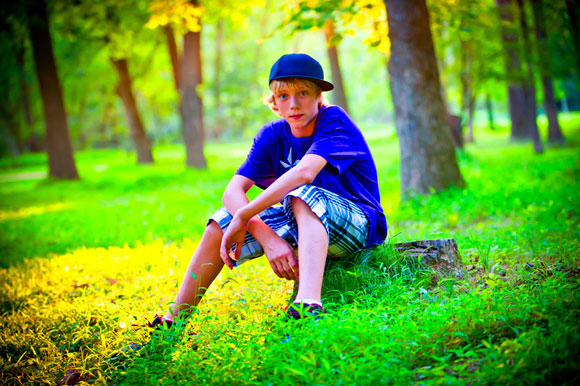If I may briefly introduce myself, my name is William Petruzzo. I own and operate Petruzzo Photography, a Maryland wedding and portrait photography outfit. Though the business began in 2004, I have been pursuing photography for the better part of fifteen years. My own entrance into photography began with some primitive digital cameras and that is what I know best. And as such, I’m also intimately acquainted with the mistakes I bring before you today.
Almost all new photographers suffer from the same practice. Over-processing. It’s the mistake of taking a good photograph and making adjustments until it’s a mediocre photograph at best. In pre-digital times this wasn’t much of an issue because editing a photograph would require advanced techniques in the darkroom. And besides, most people were having their photos developed at the local photo lab anyway.
Today, editing your photos is seen as a must by some. For amateurs and professionals there is a bit of truth to this, but that doesn’t mean edits always have to be obvious. In fact, most of the time they should probably be invisible to the untrained eye.
So, in the interest of saving some new photographers a few painful months of heartache as they make the same mistakes many of us have already made, here are what I consider the three most common ways to over-process your photos and how you can avoid them.
The Night and Day Difference of Too Much Contrast
Perhaps pitfall number 1. It’s true that digital cameras, especially if you’re shooing your images in RAW, tend to have somewhat lackluster contrast. They can lack the drama that many of us began our adventure in photography to create. Increasing contrast is a subtle way to help bring out that drama. But the operative word there is ‘subtle’. When you increase your contrast, light areas in your image appear become brighter while dark areas appear to become darker. This can make shadows harsher and you can inadvertently throw away lots of detail that may have improved the image.

If you increase the contrast on an image (no, not all images need it), make your adjustments very slowly. Look closely at the dark parts of your image. Are they becoming completely black, or just a tad darker? What about the light areas, are they becoming pure white, or just a bit brighter? Watch the places where light meets dark, are the edges becoming unnaturally sharp?
The Overly Colorful World of Too Much Saturation
Think of Saturation kind of like contrast, but for colors. And it’s just as easy to think pushing your saturation too far will do your image good, even when it probably never will. When you increase your saturation, you’re actually reducing the number of colors in your image. This means that color gradients (for example, a tree where the leaves are varying shades of green), and similar colors across your image, will start to become more like the same color. Greens with a hint of blue will become more like green, reds with a hint of yellow will become more like red, yellow with a hint of blue will become more like yellow. And on top of that, the more saturation you add, the more your colors will go to their absolute extreme (trees becomes neon green, skin tones become bright pink, etc.)

The hard cold truth is that most images need very little saturation increase, if any. When you adjust your saturation, do it little by little. Look at the image, do the colors look like they did in real life? If so, you’re probably on the right track. Once you have it right, you can decide if you want to increase it further for stylistic reasons. But from this point, you’ll know that you’re stepping out from what is probably “correct”, in a textbook sense.

What’s Behind That Vignette
Vignetting is a natural occurrence in photography that comes from a variety of sources, such as the glass elements inside the camera’s lens and natural phenomenon. In practice, it’s when the edges of an image, corners especially, are darker than the center. Vignetting adds a subtle sense of organics into the image. A ‘film’ look, as some might say (though vignetting has almost nothing to do with whether a camera is film or digital—this perception likely comes from today’s higher quality optics at a consumer level).

However, many new photographers never worked with equipment that naturally created the effect and therefore they often have no idea when to say enough is enough. There are at least two ways you can combat your risk of over-doing your vignetting. First, start by looking through old photo albums and modern photography magazines and look closely for the vignette. Is your vignetting a lot more dramatic than what you see there? If so, and that surprises you, you probably need to back it off some. And second, if you look at your image from a distance, can you clearly and obviously see the shape of the vignette? If so, again, consider backing it off a tad.
An Important Point of Clarity
This article is written for those who are stepping out bravely into the photographic hobby. Many of you are still looking for your voice as a photographer and in the process you will likely make many of these mistakes. While I’ve written this as though failing to follow these guidlines will result in a bad image, that is not necessarily the case.
Photography is not a science. And certainly not an exact science. Sometimes an image should have unnaturally high contrast, or intense vibrant colors. Maybe artistically, that’s just the way you want it. But if that’s the case, it shouldn’t be an accident. So learn to do it “right” first, then do it however you want.
Links:
http://www.petruzzo.com/
https://www.facebook.com/petruzzophotography
Please include one post talking about people adding HDR on all photos like: Portraits at any hour of the day. I have a dear friend that always does that and I don’t know how to ask him to Please STOP!!!
Nice article. It is important to always keep that in mind, I am very fond of the vignetting and I need to control myself.
I have two thoughts for you:
1. If your friend is making a conscious decision to use HDR in a ton of images that’s probably a style they really like. There’s nothing wrong with that. It might just mean that you don’t like their style of photography. And there’s nothing wrong with that either.
2. But, if as a concerned friend, you’re thinking they may be stagnating as an artist, try saying things like, “This image is really interesting. I wonder what it might be like if it were processed differently.”
Artists, we’re a sensitive bunch.
Kudos for points 1, 2 *and* 3 😉
The way I see it, there’s three ways to view HDR: one, overblown kid-with-new-toy pratting-around; two, as a style; three, as a tool.
It can be hard to tell which of these any one photo falls into – hence why I wondered recently if viewers need to see multiple works from an artist to gauge their style – but of the three, I think “realistic HDR” and “use it as a tool” pair together well.
Interesting Bill. Nonetheless perhaps you could include a fourth, (arguably IMHO the #1 Most common way of overprocessing), which is over sharpening. This is often because the amateur processor does not understand the Photoshop “Unsharpen” tool and does not enlarge ther image enough to see oversharpening halo etc.
A follow up could be the three most underused processing functions…
Kudos for writing this in a way that isn’t putting down people who are just learning and making these mistakes. I’ve seen too many professionals out there with a negative attitude towards other people who are still learning their way.
Anna-I completely agree. While I have many things to learn, I have “new” photographers come to me and I do all I can to mentor to them. Thank you Bill, this is something that I would recommend to anyone but some may feel it doesn’t apply to them. Again, thank you each for your great comments and article.
This warning is a good start to a plethora of “over-processing” faux pas, in the world of digital photography.
It’s a little bit like the terrible images made on film, by the over-use of filters, cross-processing, etc.
All processes In the hands of a restrained creator can lead to beautiful images. In the hands of an excited enthusiast, they most often result in kitsch.
Grewt article, I for one have done all the above, I think another one would be the overuse of the Clarity slider in Lightroom. When overused this can create halos and blown over sharpened areas as ell.
Totally well written. I’ve done all of the above, especially when I was first starting out. I look back on those images and think, “What was I thinking!?” And then I hope no one else knows they exist. (part of it was also I was editing on a laptop that had quite possibly the worst color calibration ever — so I didn’t even realize how my photos looked until I saw them on another computer *shudders*). There’s nothing wrong with “creative” editing that doesn’t use true to life colors, but there is an obvious difference when it is done intentionally and when it is just an overprocessing faux pas.